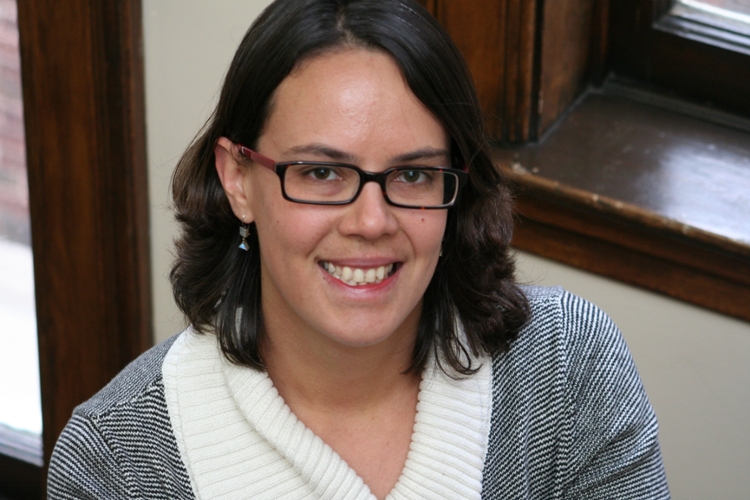Faculty Spotlight: Cynthia Kinnan
Adding rigor to poverty research
Get all our news

Throughout her career, IPR economist Cynthia Kinnan has sought to bring scientific tools to the conversation about poverty in the developing world.
“At that time, there really wasn’t a lot of hard, rigorous evidence on either side of that discussion about how best to address the phenomena of underdevelopment and poverty in parts of the world,” Kinnan explained.
That realization led Kinnan to the study of development economics and her PhD, and ever since, she has sought to use randomized controlled trials (RCTs) and other scientific tools to inform the conversation around the causes and consequences of poverty in the developing world.
The impact of microfinance
Many have hailed microfinance as a miracle cure for poverty, but work by Kinnan with Abhijit Banerjee, Esther Duflo, and Rachel Glennerster, published in 2015 in the American Economic Journal: Applied Economics, has helped lead to a “rethink” of the role of microfinance, debunking the notions that its uptake was nearly universal and that it would have immediate, transformative impacts.
Currently, Kinnan is examining questions about what exactly microfinance should be expected to do. Should it be thought of like a personal loan, helping households buy a new roof or improve their latrine; or a small business loan, aiding entrepreneurs in creating or expanding their venture? She believes the correct answer is both.
“If you only look at business creation or if you only look at consumption, you’re going to miss part of the picture,” Kinnan said.
In a recent IPR working paper, she investigates these questions through a natural experiment in India. In 2010, the state of Andhra Pradesh issued an emergency ordinance that halted all of its microfinance activities due to concerns about overborrowing and aggressive loan collection practices. The consequences quickly spread beyond Andhra Pradesh: Since affected microfinance institutions could not seek repayment of past loans, they had less to lend in other states. Larger lenders, meanwhile, became hesitant to lend to microfinance institutions, fearing similar actions by other states.
With Emily Breza of Harvard University, Kinnan discovered that the lower credit supply was associated with a 5–9 percent drop in wages. Because people had less money to spend, consumer spending, investment, and entrepreneurship also dropped. Because some of microcredit’s impact occurs through wages, studies comparing borrowers and nonborrowers in the same labor market would miss a portion of the picture. This underscores the need for both RCTs and natural experiments, which have different strengths and weaknesses.
Kinnan notes that it is key for policymakers to understand how people can respond differently to credit when designing financial inclusion policies and when targeting financial products to specific groups.
The value of health insurance
India’s Prime Minister Narendra Modi recently announced a program to provide health insurance for up to 500 million low-income Indians. Once rolled out, the National Health Protection Scheme, known as “Modicare,” could become the world’s largest government health insurance program.
Kinnan notes that Modicare’s predecessor, Rashtriya Swasthya Bima Yojana (RSBY), suffered from low uptake. Though it cost participants just 30 rupees ($0.47) to enroll, only 54 percent of eligible families signed up.
“You don’t want to incur the cost of creating a health insurance system and recruiting hospitals, only to then have very few people sign up for it or utilize it,” Kinnan said.
Low enrollment rates could also be a problem for Modicare, but Kinnan’s recent evaluation of an RSBY expansion (with Gabriella Conti, Kosuke Imai, Anup Malani, and Alessandra Voena) offers a possible solution. By going door to door to inform newly-eligible households about their eligibility and helping them enroll, they registered 79 percent enrollment rates when they offered free insurance. Even when insurance was sold at cost, with no government subsidy, enrollment rates were higher than typical, coming in at 60 percent.
But what good is insurance if enrollees cannot use it? Kinnan and her coauthors found that a significant number of households attempted to use their RSBY card but failed. Some individuals forgot their insurance card or did not know it could be used. And about half of the time, the hospital or insurance company could not process the card or refused to cover the care.
Although 33 percent of hospitals in the Indian state of Karnataka participated in RSBY, 55 percent of those participating filed no claims. They reported they were open to RSBY participants but did not actually treat them.
To solve this issue in Modicare, Kinnan recommends higher reimbursement rates for treatment, otherwise hospitals will try to refuse care. India could also leverage its IT prowess to create a digital paper trail, allowing regulators to see attempted uses of the insurance.
“When your resources per person are limited, you need to use those resources in the most efficient way possible,” Kinnan said. “That’s why getting the implementation of health insurance right is key.”
Cynthia Kinnan is an assistant professor of economics and an IPR fellow.
Published: February 28, 2018.